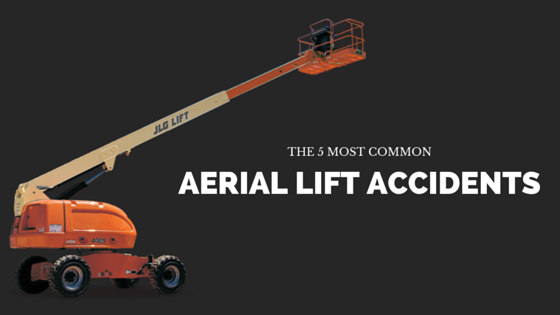Everything You Should Know On Aerial Lift Accidents




A Closer Look at Aerial Lift Accidents
Aerial lift accidents can occur without notice and wreak havoc on a business, its employees, and its customers. Common categories of aerial lift accidents include:
1. Boom Lift Accidents
Boom lifts can fall over, and when they do, produce some of the highest aerial lift accidents due to their height and horizontal reach.
2. Scissor Lift Accidents
A scissor lift accident is often caused by driving and working on uneven ground or falls and tip-overs that occur due to severe weather.
3. Manlift Accidents
Falls, tip-overs, and collapses are among the top dangers that can lead to manlift accidents.
4. Genie Lift Accidents
Although Genie lifts are used in many industries worldwide, they must be managed properly. Otherwise, workers risk Genie lift accidents that put their health and well-being in danger.
OSHA requires businesses to plan for accidents. If your company has aerial lift operators on staff, it must teach them about common accidents. Failure to do so can be costly to your business. It puts your aerial lift operators and others in danger, too.
Why OSHA Aerial Lift Certification Is Key
Aerial lift operators who lack OSHA-approved training are more prone to accidents than others. They risk operating errors that can lead to aerial lift accidents, along with equipment and property damage. Even worse, aerial lift operator accidents can cause serious injury or death. They can also result in OSHA fines and penalties, brand reputation damage, and revenue losses.
OSHA certification training won’t stop accidents on aerial lifts. Conversely, the training puts a company and its aerial lift operators in the best position to avoid such issues.
Certification training provides insights into different types of aerial lift accidents. Upon completion, aerial lift operators can keep an eye out for hazards that can lead to these accidents.
Certification helps businesses meet OSHA requirements, too. Training ensures that companies can offer workers the training they need to guard against aerial lift accidents. A little training can go a long way – you’d be surprised at how quickly employees can pick up new skills to become more productive while reducing the odds of a workplace accident. There’s no doubt about it: proper training and certification benefits everyone.
Aerial Lift Accident Statistics


Notable data from this research includes:
– Among trades, electricians (25%) account for the most deaths among professionals using aerial lifts, followed by construction laborers (15%) and electrical power installers and repairers (13%).
– Boom lifts accounted for nearly 70% of aerial lift deaths.
– Scissor lifts accounted for approximately 25% of aerial lift deaths.
Aerial lift operators must work cautiously, regardless of worksite or the type of lift they use. That way, these operators can remain productive without putting themselves or bystanders in danger. They can also avoid common aerial lift accidents.
Five Common Aerial Lift Accidents
The risks associated with using untrained workers on different types of lifts can be significant. To show the dangers of using untrained workers on aerial, boom, and scissor lifts, here’s a look at the five most common accidents at aerial lift worksites:
1. Electrocutions
The number of electrocutions in the construction industry rose 18% year over year, according to the most recent data from the Electrical Safety Foundation International. With a deep understanding of electrocutions, workers can take steps to protect themselves and others against electrocutions and other electrical injuries.
Electrocutions occur when workers make contact with overhead power lines. They can also happen when a lift makes contact with a power line.
Telescopic booms have the highest risk of electrical accidents. This is because they are often used to service electrical systems.
Scissor lift operators often work near or under power lines. They risk getting a fatal electrical shock in many different ways, such as:
- Operators do not use personal protective equipment (PPE).
- The lift is unstable.
- Contact is made with live power lines due to a lift tip-over.
Aerial and scissor lift training teaches workers how to assess a work area for overhead live wires and other hazards. In doing so, the training can help workers avoid fatal shocks from power lines.
2. Falls from Aerial Lifts
Aerial lift falls are one of the leading causes of death among construction workers, the U.S. Centers for Disease Control and Prevention (CDC) reports. They are most likely to occur when a worker, aerial lift, or scissor lift is hit by a crane, vehicle, or another object.
Fall protection measures are crucial to limit the risk of falls from aerial lifts. All cables and harnesses must be attached to a lift before starting a job. In addition, when operating a lift, workers must ensure that:
- Access gates are closed.
- The body harness or restraining belt is attached to the boom or bucket with a lanyard.
- They are standing firmly on the floor of the bucket.
- They avoid leaning on or climbing over the guardrails.
OSHA-approved safety training provides tips and strategies to prevent falls from aerial lifts. With a comprehensive aerial lift safety training program, workers can learn which precautions can help them reduce the risk of aerial lift falls and other accidents.
3. Aerial Lift Tip-Overs
Aerial lift tip-overs most often occur when a bucket cable or boom breaks. They can also happen when a bucket falls or a scissor lift tips over.
To avoid these manlift accidents, workers should never:
- Set up an aerial lift between overhead hazards
- Exceed load capacity limits
- Travel to a jobsite with an elevated lift
- Use a lift on uneven terrain
- Raise a platform in windy conditions
Workers can learn how to identify and eliminate aerial lift tip-over risks and other aerial lift accidents, too. In fact, with proper training, workers can learn how to assess a worksite for tip-over hazards that can contribute to boom lift accidents and other workplace dangers.
4. Getting Caught Between a Lift and an Object
Injuries due to contact with objects outside a bucket occur when the bucket is being moved and a worker gets caught between the edge of the bucket and a roof joist, beam, or another object.
To prevent this type of accident, workers should perform a worksite inspection and evaluate their work equipment. Rotating or moving machine parts must be properly guarded, and workers should not wear loose clothing. Also, workers on the ground should remain at a safe distance from the load at all times.
Scissor lift operators should stay clear of overhead hazards like power lines, pipes, and ceilings to minimize the risk of scissor lift accidents as well. Meanwhile, on-foot workers should remain a safe distance from a work area.
Workers can learn about the dangers of getting caught between a lift and an object, how to avoid getting crushed by a lift or overhead objects, and other aerial lift safety tips and strategies as part of an aerial lift certification training program. Best of all, workers who complete this program can learn how to identify aerial lift dangers, eliminate these risks, and prevent accidents.
5. Being Struck by Objects Outside the Bucket
Collapsing materials cause accidents that occur when workers are unaware of their surroundings and make contact with objects that come loose.
Workers must notify their superiors and stay up to date about any unfinished building materials at a jobsite. They should also take steps to prevent materials from coming loose; if these materials come loose, they could strike people on the platform or on the ground and lead to injuries and fatalities.
It is important to note that human error can play a role in any of the aforementioned aerial lift accidents, too. For instance, careless aerial lift operators may take shortcuts that inadvertently lead to accidents. Or, lift operators who ignore a jobsite’s rules may cause accidents.
No one is perfect, but a consistent approach to everyday work can help aerial lift operators minimize the risk of mistakes. When it comes to human error that can lead to aerial lift accidents, training is crucial. Because if aerial lift operators are properly trained, they will know how to safely use a lift. They can also take precautions to prevent aerial lift accidents.
How to Stay Safe on Aerial Lifts
Aerial lift operators must prepare for accidents. A clear understanding of aerial lift hazards ensures operators can guard against them.
Also, aerial lift operators must use their machinery carefully. Even a small mistake can cause a major aerial lift accident. By operating an aerial lift with precision, an operator can avoid errors.
Finally, staying up to date on OSHA certification for aerial lifts is paramount. OSHA certification remains valid for up to three years. Only licensed operators can use aerial lifts at U.S. worksites. If you ensure your operators are in compliance with OSHA standards, you can verify they know how to safely use an aerial lift.
Aerial Lift Accidents
While aerial lifts can be quite safe to use most of the time, accidents do happen on occasion. A look into a few examples of such incidents can shed light on why aerial lift accidents happen:
Montana Man Dies in Aerial Lift Accident
A routine day at work turned disastrous for a 46-year-old Butte, Montana man. He and a colleague were in the bucket of a Genie S-60 that was still loaded onto a truck. The operator was adjusting the boom over the side of the truck when the entire lift was tipped over. The man was flung out of the bucket and suffered serious injuries. Despite being airlifted to the hospital, he succumbed to his injuries. OSHA levied a fine against his employer for failing to report the incident within the required eight hour period, but more fines may be on the line. Investigators suspect the operator may not have been wearing his safety harness at the time of the aerial lift accident.
Scissor Lift Accident Kills Department of Administration Employee
A North Carolina man died in a fatal aerial lift accident while working at the State Archives building in Raleigh. He and a colleague were using a scissor lift to access an outside light when the machine tipped over, falling on top of him. Initial investigations revealed that the scissor lift malfunctioned, but no further details were given about its maintenance and repair history. While freak accidents sometimes occur, many of the most common forklift malfunctions can be caught ahead of time with a thorough inspection.



Sign Up for Aerial Lift Certification Training from CMO
CertifyMeOnline.net offers a full selection of aerial lift, scissor lift, and mobile elevated work platform (MEWP) training courses.
We provide courses to teach entry-level and experienced workers how to operate different types of aerial lifts in accordance with OSHA standards. Each course is designed to teach workers how to address boom lift accidents and other worksite dangers and prevent these issues from becoming recurring problems. And you can enroll your workers in any of our courses at your convenience.
Many training courses are available that focus on scissor lift accidents and other aerial lift dangers. To learn more, please fill out our online form or call us today at (602) 277-0615.